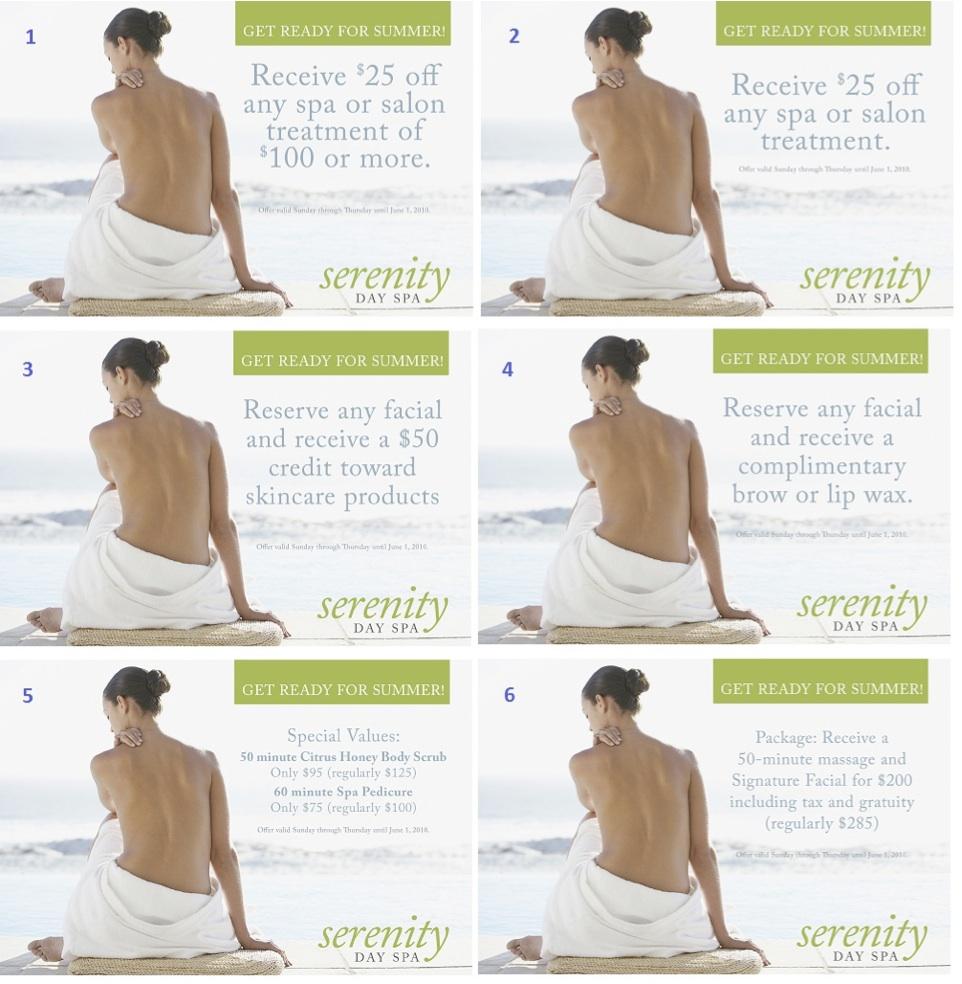In Coyle’s Global Spa Survey, we presented respondents with six advertisements. All had the same background image but contained different offers. Respondents were then asked to rate each advertisement from ‘very appealing’ to ‘very unappealing’. Respondents were then asked to tell us ‘why’ certain advertisements appealed to them and others did not. The advertisements that were presented are as follows:

The results of the ratings are as follows with the highest concentration of responses highlighted in orange for each advertisement:
Advertisement #2, which featured $25 off with no minimum purchase requirement, was by far the favorite with 91% ranking it at least ‘appealing’. Advertisement #1, which offered a dollar discount off with a minimum purchase, had 77% respond within the ‘appealing’ categories. The other advertisements had a more tepid response with the ‘appealing’ categories coming in between 45% and 58% and ‘unappealing categories’ between 24% and 32%.
The top reasons provided by respondents for liking particular advertisements over others were:
- They had a choice of what service to apply the discount to (24%)
- The discount appeared to be large and they felt like they were getting a bargain (21%)
- The discount offered had no minimum expenditure (18%).
- The free service (with purchase) was something they could utilize (9%)
- The offer contained less words or was simple/concise (9%)
- The offer was straightforward, not complicated or convoluted (8%)
Some other comments included that there were ‘no strings attached’, that they could visibly see what they were saving and that it was something they would purchase anyway.
The least appealing of the advertisements, based on the ratings by respondents, were advertisement #3 (32% in ‘unappealing’ categories), which offered a $50 credit toward skincare products with the purchase of a facial, and advertisement #4 (30% in ‘unappealing’ categories), which offered a complimentary brow or lip wax with any facial.
When respondents were asked why they did not like one or more of the advertisements, they stated the following most frequently:
- The treatment offered was unappealing (17%)
- A free product offer was not appealing/they would feel obligated to purchase product (13%)
- The advertisement was too cluttered, confusing or had too much text (10%)
- The (entry) cost was too high (9%)
- The font was small (6%)
- The discount was not significant enough (6%)
- The offering was too specific/limited (6%)
Interesting to note as well was that 3% of respondents said that ‘waxing’ creates an unpleasant image, referring to Advertisement #4, and many elaborated significantly and with passion on this topic. It appeared to have a negative, galvanizing effect, so spa owners would be wise to consider that the benefit of the offer should have universal appeal.
Other general comments were that the treatments offered were too functional and did not promote luxury or relaxation, that date restrictions were off-putting and that they do not like to have a minimum expenditure to qualify for a discount. And while our sample ads were very specific, we read enough commentary to provide the following takeaways:
Consumers prefer minimal restrictions including:
- No minimum purchase
- No date restrictions
- No required product purchase (even if you are giving it away)
- No treatment restrictions
Consumers prefer clear, concise delivery of the ‘deal’ including:
- Large, easy to read font
- Limited ‘fine print’
- Clear, definitive discounting
Consumers prefer meaningful ‘deals’ including:
- Those that promote relaxation
- Those that contain things they would or would like to do anyway
- Those that contain a significant value
Keeping these key takeaways in mind, we understand that spas are businesses and need to be profitable. Deals that meet the consumers’ want-lists can not be in place for every guest on every visit, or spas would simply be upside down. Additionally, though the consumer may want all of the freedom in the world, giving them freedom in one area and not another can still yield the same positive effect. For example: advertisement #2, the favorite, had no minimum purchase, no required product purchase, no treatment restrictions and clear and concise delivery. It did not, however, specifically promote relaxation or contain a significant value (compared to the other advertisements), and it did have date restrictions.















